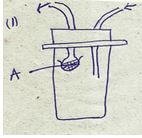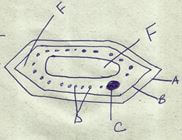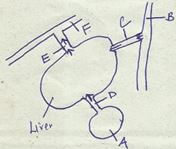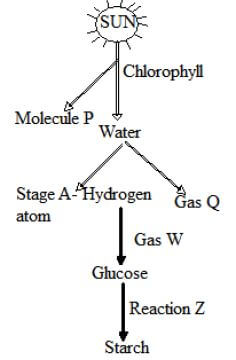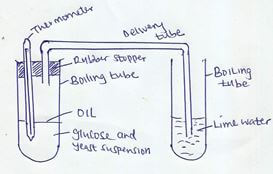BIOLOGY
FORM 2 OPENER EXAM
TERM 2 2021
INSTRUCTIONS
- Answer all the questions
SECTION A
- Study the diagram below
- Name the apparatus (1mk)
- Suggest the use of the apparatus. (1mk)
- Name the part labeled A and state its function. (2mks)
- Name the field of biology that specializes in the study of the following; (3mks)
- Insects
- Interrelationships between organism and their environment.
- Heredity and variations.
- The structure below was observed under the light microscope.
- Identify the cell structure. (1mk)
- Name the parts labeled A and B (2mks)
- State two functions of the above structure. (2mks)
- The diagram below shows a certain cell in living organisms.
-
- Identify the cell (1mk)
- Give two reasons for your answer (2mks)
- Name the parts labeled;A, B,C,D,E and F (3mks)
- State the functions of the parts labeled C, D and E. (3mks)
-
- Name the organelles in a cell which perform the following functions. (3mks)
- Excretion in Amoeba
- Secretion of synthesized proteins and carbohydrates.
- Formation of cilia and flagella.
- The diagram below represents a cross section of a plant part.
- From which part of the plant was the section obtained? (1mk
- Name the parts labeled A,B and C. (3mks)
- What is the function of the part labeled C? (2mks)
-
- What is transpiration? (1mk)
- Give two importance of transpiration in plants (2mks)
- Name two sites for transpiration (2mks)
- Name the instrument which is used to determine transpiration rate. (1mk)
- Name the : (2mks)
- Material that strengthens the xylem tissue
- Tissue that is removed when the bark of a dicotyledonous plant is ringed.
- Name the blood vessel that transports blood from; (2mks
- Lungs to the heart
- The aorta to the liver
SECTION B 40 MARKS
- The diagram below illustrates blood circulation in certain organs in humans.
- Name the part labeled A ……………………………… (1mk)
- Name the blood vessels labeled B,D, E and F. (4mks)
- State how the composition of blood in vessel E differs from that in vessel D. (3mks).
- Explain the role of bile in the process of digestion (2mks)
- Below is a diagrammatic summary of the main biochemical events in photosynthesis. Study it carefully and answer the questions that follow.
-
- Define photosynthesis (1mk)
- Name the stages A and B (2mks)
- Name the gases represented by the letters Qand W(2mks)
- Name the specific site for the reactions in stage A and B (2mks)
- Name reaction Z ………………………………………….. (1mk)
- What name is given in splitting water molecule into hydrogen atom and gas Q? (1mk)
- Name one factor that affect the rate of photosynthesis (1mk)
-
- An experiment was set up as shown in the figure below.
The glucose solution was boiled and cooled before adding yeast. The set up was left in stand for about 30 minutes.- What changes occurred in the
- lime water (1mk)
- glucose and yeast? (2mks)
- Explain your answer in (a) above (3mks)
- Name the process that was being investigated. (1mk)
- What was the role of oil in the boiling tube? (1mk)
- Suggest control experiments for the above experiment. (2mks)
- Suggest the reason for boiling and cooling glucose before adding yeast. (2mks)
- What changes occurred in the
-
- Distinguish between heterodonts and homodonts. (2mks)
- What is the significance of diastema in herbivorous mammals? (1mk)
- State the role of carnassial teeth in a lion? (1mk)
- An organism was found to have the dental formula:
i 1 C 0 P 3 M 4
1 0 2 4- Calculate the total number of teeth in the organism (1mk)
- With a reason suggest the mode of feeding of the organism from which dental formula was obtained. (2mks)
- State one adaptation of the animals that uses the mode of feeding above. (1mk)
SECTION C
- Briefly describe the role of Osmosis in living organisms (10 mks)
- Explain 5 factors affecting the rate of breating in human beings. (10 mks)
MARKING SCHEME
-
- Pooter
- For sucking small animals from rock’s surface or barks of trees.
- Mosquito netting;
To prevent dirt from entering the suction tube;
-
- Entomology
- Ecology
- Genetics
-
- Cell membrane
- B- Protein layer
- A- Phospholipids layer
- Allows selective movement of substances in and out of the cell;
Encloses cell contents;
-
-
- Plant cell
- Presence of cell wall;
- Large vacuole which is centrally located.
- [A – Cell wall B- Cell membrane C- Nucleus D- Chloroplasts E- Sap Vacuole F- Cytoplasm] 6/2 mks
-
- D- They form sites for photosynthesis
- E- store sugars and salts
Osmoregulation/contribute to the osmotic properties of the cell. - C- controls all activities of a cell.
-
-
- Contractile vacuoles
- Golgi apparatus/bodies
- Centrioles
-
- Stem; of the dicotyledonous plant.
- A- phloem B- Cambium C- Xylem
-
- Offers support
- transport water; and dissolved mineral salts up the plant;
-
- It is the process by which water in form of water vapour is lost to atmosphere.
-
- It helps in replacing water lost through leaves,
- Through transpiration mineral salts and water are transported up the plant
- Brings about cooling effect to plants
- Stomata; lenticels and cuticles (any 2)
- Potometer
-
- lignin
- Phloem
-
- pulmonary vein
- hepatic artery
-
- Ileum /small intestines
-
- B- Aorta
- D- Hepatic portal vein
- F- vena cava
- E- hepatic vein
-
E D more urea less urea Less glucose more glucose less amino acids more amino acids less oxygen more oxygen more carbon(iv)oxide less carbon(iv)oxide -
- common bile juice which emulsifies/break down fats into(small)droplets; decreasing their surface for action by lipase enzymes
- neutralizes acidic chime; (from stomach)
- Provides a suitable alkaline medium for pancreatic enzyme (Any two correct)
-
-
- Process by which green plants manufacture their own food in presence of sunlight as a source of energy. (1mk)
-
- A- Light stage (1mk)
- B- dark stage (1mk)
-
- Q- Oxygen(1mk)
- W –carbon(iv) oxide(1mk)
-
- A- Granum (1mk)
- B - stroma (1mk)
- Condensation (1mk)
- Photolysis
-
- Temperature
- Carbon(iv) oxide
- Light intensity
- Water availability (Any correct)
-
-
-
- There was formation of a white precipitate (1mk)
- glucose/ yeast mixture- there was a rise in temperature (1mk)
- effervescence occurred (1mk)
-
- An anaerobic respiration/ fermentation occurred leading to production of energy and carbon(iv) oxide. (1mk)
- Fermentation led to rise in temperature, (1mk)
- carbon(iv)oxide turned limewater into a precipitate. (1mk)
-
- C Aerobic respiration/fermentation
- D To prevent entry of air into the mixture
- E use of same apparatus but in place of glucose/yeast mixture, one could use glucose alone, or yeast alone, or boiled yeast with glucose (2mks)
- F to expel any air, and cooled to avoid destroying the yeast cells (1mk)
-
-
- Heterodont dentition is the one where there are different types of teeth while homodont dentition refers to a situation where all teeth are of same size and shape. (2mk)
- It provides space for the tongue to turn and move food during chewing. (1mk)
- Modified smooth sides and sharp edges to slice through flesh and crush bones (1mk)
-
- i 1 C 0 P 3 M 4 8 2 = 30 (1mk)
1 0 2 4 6 -
- Herbivorous ; (1mk)
- Because they lack canines (1mk)
- i 1 C 0 P 3 M 4 8 2 = 30 (1mk)
- presence of diastema for manipulation of food during chewing
-
- Absorption of water from soil by root hair; Root hair cells of a plant absorb water from the soil by osmosis.
- Osmosis also helps in distribution of water from cell to cell. (2mks)
- Support
- plant cells gain water by osmosis; become firm and rigid giving support to seedlings and herbaceous plants. (2mks)
- Opening and closing of stomata ;
- the guard cells synthesize glucose by photosynthesis; accumulation of glucose increases their osmotic pressure thus enables them to draw water from adjacent cells by osmosis. (2mks)
- Facilitates feeding insectivorous plants;
- plants trap insects; this changes the turgor pressure (2mks)
- Osmoregulation
- Re-absorption of water from the kidney tubules occur by osmosis (2mks)
(5×2= 10mks)
- Absorption of water from soil by root hair; Root hair cells of a plant absorb water from the soil by osmosis.
-
- Physical activities- vigorous activities increase the breathing rate.
- Age – young people have higher metabolic rate and therefore breath faster than old people.
- Health – the rate of breathing increases during sickness to remove toxins from the body
- Altitude – the rate of breathing is higher at high altitudes than low altitudes because there is lower oxygen in higher altitudes.
- Emotions – body emotions affect the production of hormone adrenaline which increases the general metabolisms and hence increased breathing.
- Temperature – high temperature cause the breathing rate to increase.
- Age –young people have higher demand for oxygen . they therefore have higher breathing rate
(Any 5×2= 10mks)
Join our whatsapp group for latest updates
Tap Here to Download for 50/-
Get on WhatsApp for 50/-
Download Biology Questions and Answers - Form 2 Term 2 Opener Exams 2021.
Tap Here to Download for 50/-
Get on WhatsApp for 50/-
Why download?
- ✔ To read offline at any time.
- ✔ To Print at your convenience
- ✔ Share Easily with Friends / Students

